Fowler A. Mathematical Geoscience
Подождите немного. Документ загружается.

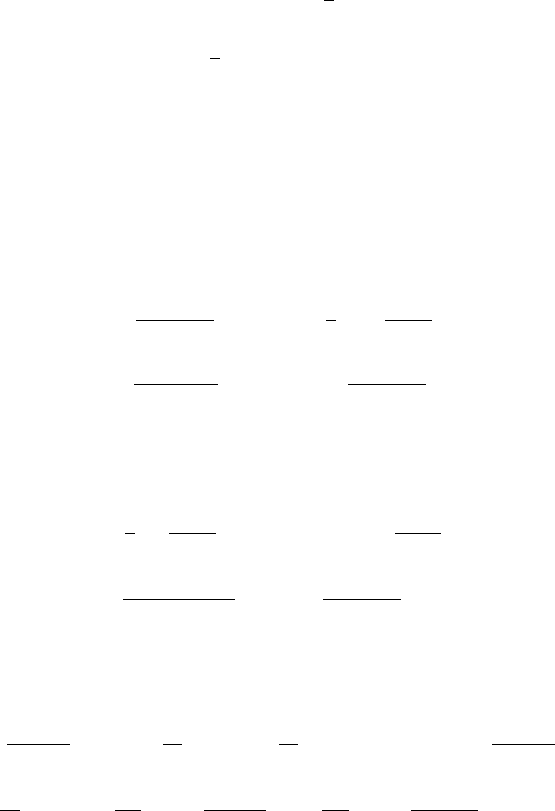
510 8 Mantle Convection
Slab Stress As ζ →−∞in the delamination layer, we have, from (8.191),
θ ∼Γζ, T
3
∼−
1
2
s
Γζ
2
,
Ψ ∼
1
2
s
ζ
2
n
Γ
n−2
e
Γζ
.
(8.247)
If we define
z =1 −νZ (8.248)
in the lid, so that the lid base is at Z =s, then (8.247) becomes
θ ∼−
Γ(s−Z)
ε
,T
3
∼−
1
2
s
Γ
s −Z
ε
2
,
Ψ ∼
s
(s −Z)
2
2ε
2
n
Γ
n−2
exp
−
Γ(s−Z)
ε
,
(8.249)
and in addition, from (8.190),
P ∼−
1
2
Γ
s −Z
ε
2
,T
1
∼−s
Γ
s −Z
ε
2
,
N ∼
2ε
2
|s
Γ |(s −Z)
2
n−2
exp
Γ(s−Z)
ε
.
(8.250)
We thus rescale the variables as follows:
θ =−
(1 −T)
ε
,P=
˜
P
ε
2
,T
1
=
˜
T
1
ε
2
,N=ε
2(n−1)
exp
(1 −T)
εT
˜
N,
T
3
=
˜
T
3
ε
2
,Ψ=
1
ε
2n
exp
−
(1 −T)
εT
˜
Ψ +
λ
ε
2n
exp
−
(1 −T
0
)
εT
0
Zu
s
(x).
(8.251)
The re-definition of Ψ merits some discussion. We add the term in λ to allow for the
small non-zero surface velocity. We anticipate that λ is of algebraic order in ε, and
so it will only be important at the surface. We include the term separately because it
is distinct from the other part of the stream function, proportional to exp(θ/ε).
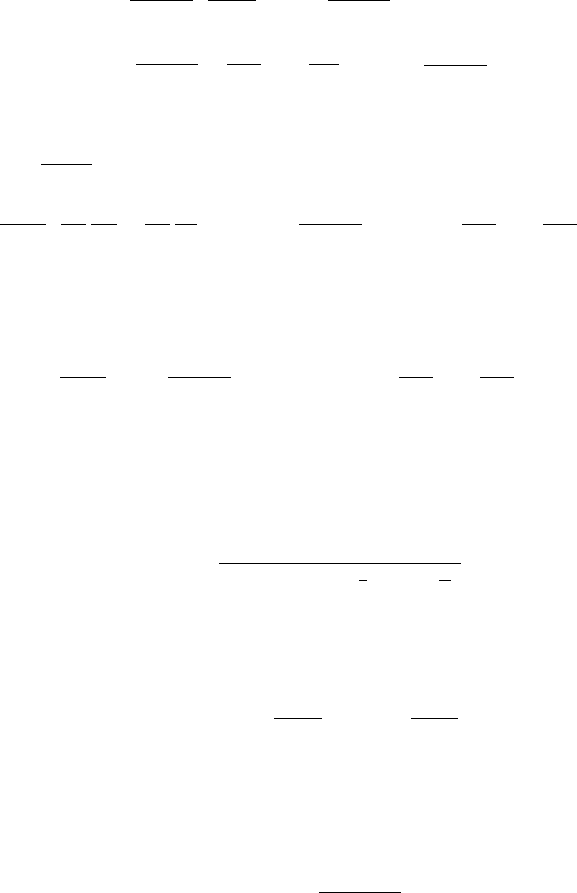
8.5 Variable Viscosity 511
Substitution of (8.251)into(8.174)(via(8.188)) leads to (on omitting the over-
tildes)
P
x
=ν
2
T
1x
−T
3Z
,
−P
Z
=ν
2
(T
3x
+T
1Z
) −(1 −T),
T
1
=2ε
2
N exp
(1 −T)
εT
∂
2
∂x∂Z
exp
−
(1 −T)
εT
Ψ +···
,
T
3
=−ε
2
N exp
(1 −T)
εT
∂
2
∂Z
2
−ν
2
∂
2
∂x
2
exp
−
(1 −T)
εT
Ψ +···
,
T
∗2
=T
2
3
+ν
2
T
2
1
,
N =
1
T
∗n−1
,
1
ε
2n+1
∂T
∂x
∂
∂Z
−
∂T
∂Z
∂
∂x
Ψ exp
−
(1 −T)
εT
+···
=
∂
2
T
∂Z
2
+ν
2
∂
2
T
∂x
2
,
(8.252)
where the dots denote the extra term λ exp[−(1 −T
0
)/εT
0
]Zu
s
, which can be ne-
glected except near the top surface Z =0.
Ignoring λ, the heat equation is
1
ε
2n+1
exp
−
(1 −T)
εT
[Ψ
Z
T
x
−Ψ
x
T
Z
]=
∂
2
T
∂Z
2
+ν
2
∂
2
T
∂x
2
, (8.253)
and we see that convection is formally negligible as ε →0, as we suppose. In prac-
tice, the value of Pe =ε
−(2n+1)
exp[−(1 −T)/εT] (a kind of Péclet number) at the
surface, where T = T
0
= 0.2 for the Earth, is approximately ε
−8
e
−4/ε
if n = 3.5,
and for our preferred value of 0.023, this is about 4 ×10
−63
.ThevalueofT where
Pe = is
T
=
1
1 +(2n +1)ε ln
1
ε
+ε ln
1
, (8.254)
and for moderate <1 and n =3.5, T
≈0.59. Thus the high value of n and low ε
combine to yield a viscous structure which is only truly rigid for T<T
. Figure 8.5
illustrates this by plotting the approximating viscosity function
N
app
(T ) =
ε
1 −T
n−1
exp
1 −T
εT
(8.255)
(gleaned from (8.250)) for ε = 0.023, n =3.5. Evidently, the formal limit N
app
=
exp[O(1/ε)] only occurs practically for T
<
∼
0.7, and advection is only truly negli-
gible for T
<
∼
0.6. Some inaccuracy can be expected in the theory.
Neglecting advection, we have the approximate conductive profile (for ν 1)
T ≈T
0
+
(1 −T
0
)Z
s
(8.256)
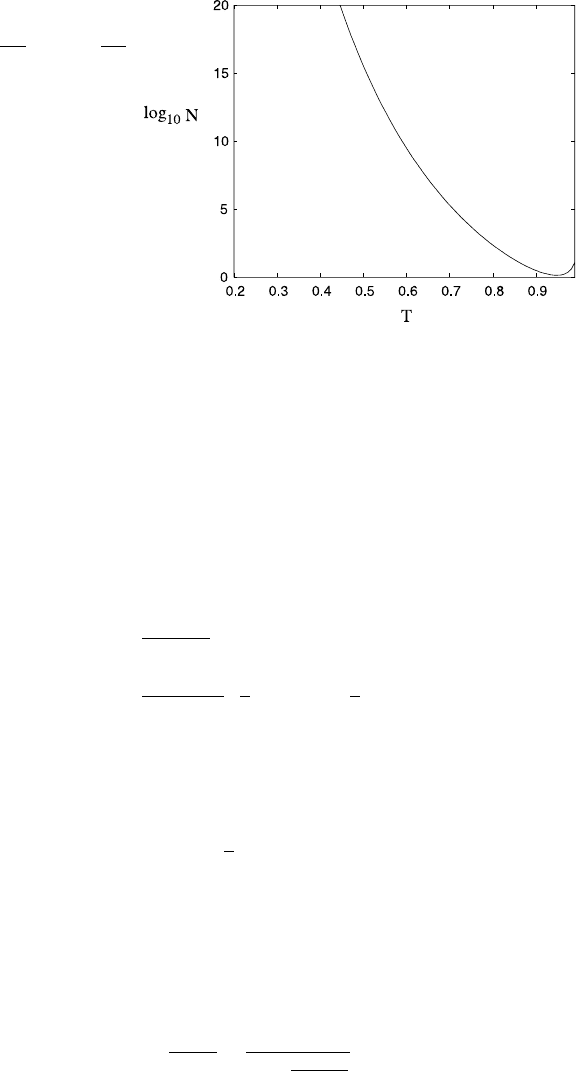
512 8 Mantle Convection
Fig. 8.5 The
pseudo-viscosity function
N
app
(T ) = (
ε
1−T
)
2n−1
exp{
1−T
εT
},
for n =3.5andε =0.023
and thus P and T
3
, satisfying
P
x
≈−T
3Z
,
−P
Z
≈−(1 −T),
(8.257)
together with the matching conditions (from (8.249)) P,T
3
→0asZ →s,aregiven
by
P =−
(1 −T
0
)
2s
(s −Z)
2
,
T
3
=−
(1 −T
0
)s
2s
2
2
3
s
3
−s
2
Z +
1
3
Z
3
.
(8.258)
We are unable to satisfy the condition of zero shear stress at the top surface Z =0,
since there is a residual shear stress there given by
T
0
3
=−
1
3
(1 −T
0
)ss
. (8.259)
In order to enforce T
3
= 0atZ = 0, the shear stress must change rapidly in a
boundary layer near Z = 0. Why should such a boundary layer exist? Notice that
we also require the stream function to vanish, i.e. Ψ =0atZ = 0. To solve for Ψ ,
we expand the expressions for T
1
and T
3
in (8.252). If we put
V(T)=
1 −T
T
≈
1
T
0
+
(1−T
0
)Z
s
−1, (8.260)

8.5 Variable Viscosity 513
then we find
T
1
=2N
V
Z
V
x
Ψ −ε(V
Zx
Ψ +V
Z
Ψ
x
+V
x
Ψ
Z
) +ε
2
Ψ
xZ
+ε
2
λ exp
(V −V
0
)/ε
u
s
,
T
3
=−N
V
2
Z
Ψ −ε(2V
Z
Ψ
Z
+V
ZZ
Ψ)+ε
2
Ψ
ZZ
+ν
2
N
V
2
x
Ψ −ε(2V
x
Ψ
x
+V
xx
Ψ)+ε
2
Ψ
xx
+ε
2
λ exp
(V −V
0
)/ε
Zu
s
,
(8.261)
where V =V
0
at T =T
0
. Away from Z =0, we have
T
1
≈2NV
x
V
Z
Ψ, T
3
≈−NV
2
Z
Ψ, (8.262)
thus Ψ =0atZ =0. The presence of a term ε
2
Ψ
ZZ
in (8.261) suggests the existence
of a boundary layer of thickness ε over which Ψ can drop to zero. It is in order to
get the shear stress T
3
to zero as well that we introduced the extra stress term in λ.
Define a boundary layer variable ξ by
Z =εξ. (8.263)
Noting that V
x
and V
Z
are O(1), we have to leading order, from (8.261),
T
1
=O(1) +2Nε
2
λ exp
V
0
Z
ξ
u
s
,
T
3
=−N
V
2
Z
Ψ −2V
Z
Ψ
ξ
+Ψ
ξξ
+O
ν
2
,ν
2
ε
3
λ
,
(8.264)
where
V
0
Z
=V
Z
|
Z=0
=−
(1 −T
0
)
sT
2
0
. (8.265)
Now we rescale P and T
1
in this stress boundary layer in order that T
3
can
change. This necessitates writing
P =
1
ε
P
∗
,T
1
=
1
εν
2
T
∗
1
, (8.266)
so that
P
∗
x
=T
∗
1x
−T
3ξ
,
−P
∗
ξ
=δ
2
T
3x
+T
1ξ
−ε
2
(1 −T),
(8.267)
and at leading order we have
P
∗
=−T
∗
1
(8.268)
(to match to P
∗
,T
1
→0asξ →∞), and thus
T
3ξ
=2T
∗
1x
. (8.269)

514 8 Mantle Convection
We can enforce the scaling T
1
∼1/εν
2
by choosing ε
2
λN ∼1/εν
2
in (8.264)
1
,
and then, since νT
1
∼ 1/εν = 1/δ T
3
= O(1), N = 1/T
∗n−1
≈ (1/νT
1
)
n−1
∼
δ
n−1
; thus we choose
λ =
1
εδ
n+1
. (8.270)
This is algebraic in ε as we required (provided one does not examine a limit in which
Ra =exp[O(1/ε)] or n ∼1/ε).
It follows from (8.264) that, since Nε
2
λ ∼1/εν
2
1,
T
∗
1
≈
2
|T
∗
1
|
n−1
exp
−
V
0
Z
ξ
u
s
, (8.271)
whence
T
∗
1
≈2
1
n
exp
−
V
0
Z
ξ/n
|u
s
|
1
n
−1
u
s
. (8.272)
Using (8.270), this gives
T
∗
1
=2
1
n
|u
s
|
1
n
−1
u
s
exp
−
(1 −T
0
)ξ
nT
2
0
s
, (8.273)
and the solution for T
3
is
T
3
=
2
B
(sf )
1 −e
−Bξ/s
−
2fs
s
ξe
−Bξ/s
, (8.274)
where
B =
1 −T
0
nT
2
0
,f=2
1
n
|u
s
|
1
n
−1
u
s
. (8.275)
The matching condition is that T
3
→ T
0
3
givenby(8.259). This implies 2(sf )
=
BT
0
3
, hence
s|u
s
|
1
n
−1
u
s
=−
(1 −T
0
)
2
3nT
2
0
2
1+
1
n
ss
. (8.276)
We require u
s
=0atx =0 and x =a. A first integral is
s|u
s
|
1
n
−1
u
s
=A
s
2
c
−s
2
, (8.277)
where
A =
(1 −T
0
)
2
12nT
2
0
2
1
n
, (8.278)
and s =s
c
where u
s
=0. It follows that u
s
> 0, and
u
s
=
x
0
A
s
1
n
s
2
c
−s
2
1
n
−1
s
2
c
−s
2
dx, (8.279)
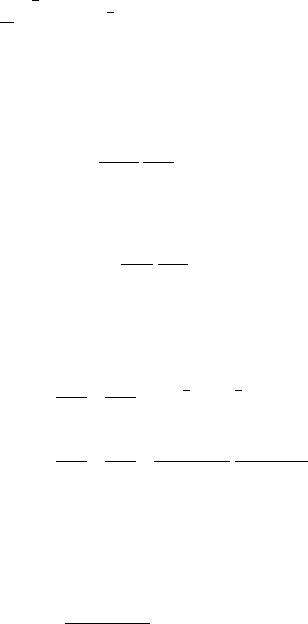
8.5 Variable Viscosity 515
and we choose s
c
so that u
s
=0atx =a,i.e.
a
0
A
s
1
n
s
2
c
−s
1
n
−1
s
2
c
−s
2
dx =0. (8.280)
Skin Stresses Looking back, we see from (8.279), (8.188), (8.251) and (8.266)
that in the stagnant lid, the dimensional shear stress
τ
D
3
∼
δ
2
Ra
ε
2
η
0
κ
d
2
, (8.281)
but within the (boundary layer) skin, the pressure and normal stresses are higher,
p
D
,τ
D
1
∼
δRa
ε
2
η
0
κ
d
2
. (8.282)
Since P
∗
+T
∗
1
≈0, the largest stress is thus the horizontal stress −p
D
+τ
D
1
≈2τ
D
1
.
Specifically, at the surface, (8.250) implies that the horizontal stress σ
S
is
σ
S
=2τ
D
1
|
ξ=0
=
δRa
ε
2
η
0
κ
d
2
2
1+
1
n
|u
s
|
1
n
−1
u
s
=
δRa
ε
2
η
0
κ
d
2
(1 −T
0
)
2
6nT
2
0
(s
2
c
−s
2
)
s
. (8.283)
It is extensional (σ
S
> 0) near the upwelling (x = 0) and compressive near the
downwelling.
We can calculate an estimate for the size of the stress,
[σ
S
]=
δ(1 −T
0
)
2
6nT
2
0
ε
2
αρ
a
gdT
a
(8.284)
using our previous estimates. We take n = 3.5, T
0
= 0.2, α = 3 × 10
−5
K
−1
,
T
a
= 1500 K, ρ
a
= 3 × 10
3
kg m
−3
, g = 10 m s
−2
, d = 3000 km; if we choose
κ = 10
−6
m
2
s
−1
and η
0
= 10
20
Pa s, then Ra ≈ 3.6 × 10
8
;ifε = 0.023, then
δ ≈ 0.013, and we compute [σ
s
]=8 kbar (1 kilobar = 10
3
bar = 10
8
Pa). This
is a huge stress, comparable to the breaking strength of rock, and is suggestive of
the idea that, within the confines of a purely viscous rheology such as we have here,
some realistic adaptation of the model should be made.
8.5.5 Summary
What have we discovered? For a purely viscous fluid with strong Arrhenius depen-
dence on temperature, high Rayleigh number convection occurs as vigorous flow
driven by small excess temperatures below a stagnant lid. This is clearly seen in
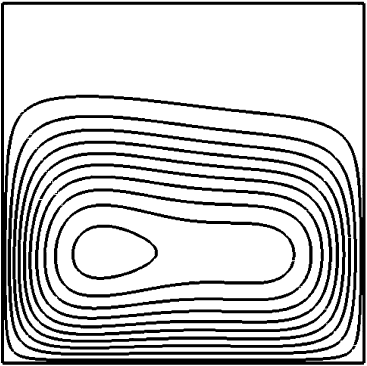
516 8 Mantle Convection
Fig. 8.6 Stream function
contours of a
temperature-dependent
viscosity convection
calculation at Rayleigh
number 10
6
, the viscosity
scaled to that at the basal
temperature. The rheology is
that of (8.176), with Λ =1,
n =1, ε =0.2. Basal and
surface dimensionless
temperatures are 1 and 0.1,
respectively. The absence of
contours towards the top
indicates the stagnant lid.
Figure courtesy Mike
Vynnycky
Fig. 8.6. In this lid, the stresses are high, and they increase rapidly in a narrow layer
near the surface. But, as with constant viscosity convection, the analysis is compli-
cated, and in parts unresolved.
At the outset, we do not even know the appropriate value of the rate-controlling
internal viscosity η
0
and temperature T
a
in the asthenosphere; a convoluted argu-
ment leads to their determination by (8.186) and (8.187), in terms of the unknown
temperature excess φ
b
at the base. The delamination layer below the lithosphere
is described by (8.191), and this introduces further unknowns: the lithosphere base
s(x), the lithospheric temperature gradient Γ , and the far field stress S
∞
(x).Of
these, Γ is given by the slab temperature field via (8.199), and S
∞
is given (in
principle) by the extra condition for the outer thermal layer in (8.211).
The core flow requires the determination of two further quantities, the plume
buoyancy constants C
l
and C
r
. Given these, then the plume/thermal boundary layer
equation (8.206) with boundary conditions (8.207) can be solved, subject to the
pseudo-periodicity condition (8.213), which in addition yields the plume head tem-
perature φ
C
(Ψ ) used in the outer thermal layer equations. Three extra conditions
are necessary to determine φ
b
, C
l
and C
r
, and in addition s must be prescribed.
We may suppose (8.212) determines C
r
;givens,(8.215) determines C
l
, and
finally (8.214) determines φ
b
. Of course, all of these relations are coupled, hence
the intent of the untangling discussion following (8.215).
The determination of s apparently forms part of the solution of the delamina-
tion equations (8.191). Further study of these equations is undoubtedly warranted.
The existence of the approximating similarity solution suggests that this is the case,
although the appropriate boundary condition for s at x =0 is less clear.

8.6 Subduction and the Yield Stress 517
8.6 Subduction and the Yield Stress
We have now arrived at the central conundrum of plate tectonics, alluded to in
Sect. 8.1. At high values of Ra and low values of ε, vigorous convection occurs
beneath a stagnant lid. Active plate tectonics does not occur in the model, as it does
on the Earth. In the lid, the stresses become extremely large, of the order of kilo-
bars, and this provides the clue to resolve the conundrum. We argue that at cold
temperatures and at such high stresses, viscous behaviour breaks down, and the
flow becomes plastic. In order to describe this, we need to reconsider the rheology
of mantle rocks in the vicinity of the Earth’s surface.
8.6.1 Near-Surface Mantle Rheology
We have already described, in Sect. 8.5.1, the viscous rheology of polycrystalline
rocks. At low temperatures, and for short time behaviour (associated with seismic
waves, for example), the mantle is elastic, and a common description of both elastic
and creeping behaviours can be represented by assuming a Maxwell viscoelastic
fluid, whose constitutive law can be represented schematically by the equation
˙ε =
τ
2η
+
˙τ
E
M
, (8.285)
where η is the viscosity given by (8.163), τ is the stress, and E
M
is an elastic mod-
ulus. (We dispense with the details of tensor representation.) The ratio
t
M
=
2η
E
M
(8.286)
thus defines a Maxwell time scale, such that for changes on a time scale t t
M
,
the behaviour is elastic, and on longer time scales t t
M
, the behaviour is viscous.
Note that the Maxwell time depends on temperature and stress.
Into this mixture we now add the concept of failure. Brittle failure is associated
with the coalescence of microcracks within the rock, and is classically associated
with an internal friction of the material. Thus brittle failure is usually associated
with the attainment of a failure stress
τ
f
=Kp, (8.287)
where p is the lithostatic pressure, and K is a dimensionless coefficient of friction
of O(1).
Geophysicists often combine these two ideas of viscous creep and brittle failure
to propose a failure diagram such as that shown in Fig. 8.7. This identifies the yield
stress with the minimum of two values, one of which is the brittle failure stress τ
f
,
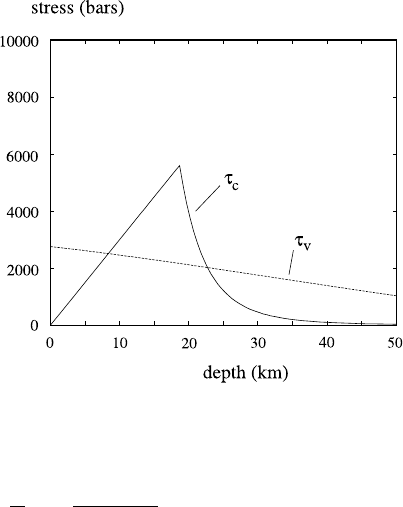
518 8 Mantle Convection
Fig. 8.7 Brittle (straight full
line) and ductile (curved full
line) yield stress τ
c
as
function of depth. The dashed
line represents a typical
corresponding lithospheric
shear stress using the
boundary layer theory for a
purely viscous mantle, with
highly temperature-dependent
viscosity
and the other is a so-called ductile failure stress τ
d
determined from the viscous
rheology (8.163), thus
τ
d
=
˙ε
A
exp
E
∗
+pV
∗
RT
, (8.288)
and τ
d
depends on temperature and strain rate. Figure 8.7 shows a typical yield
curve τ
c
=min(τ
f
,τ
d
) using a typical mantle strain rate and temperature profile as
a function of depth.
The interpretation of Fig. 8.7 is that if the stress τ (often taken to be defined by the
second stress invariant 2τ
2
=τ
ij
τ
ij
) is less than τ
c
, then deformation is elastic, but
if the stress reaches τ
c
, then it remains on the yield surface, and the deformation is
plastic. The diagram in Fig. 8.7 then looks reassuringly familiar to the yield surface
of critical state soil mechanics, with the brittle yield resembling the tension failure or
Hvorslev yield surface, and the ductile yield resembling the Roscoe yield surface.
It has to be said that the use of this diagram in this way represents a misleading
misinterpretation of the classical ideas of yield and plasticity, and it should really be
outlawed.
Firstly, the use of (8.287) is based on Byerlee’s law, which was developed to
describe rock friction and not yield in the classical plastic sense of continuing de-
formation at a critical stress. It is actually clear that the Earth’s mantle exhibits yield
at much lower stresses. For example, the motion of deep subducting slabs is by
a stick–slip motion facilitated by slip events between the descending slab and the
overlying mantle. These slip events indicate yield at a stress τ
c
which can be calcu-
lated, since it is due to the buoyant excess weight of the subducting slab, and such
estimates suggest τ
c
<
∼
300 bars, much less than one would calculate from (8.287).
Secondly, the ductile part of the curve in Fig. 8.7 is not a yield curve at all, since
it describes flow behaviour at a pre-assigned strain rate. Since the strain rate is part
of the flow problem requiring solution, this part of the curve is truly meaningless.
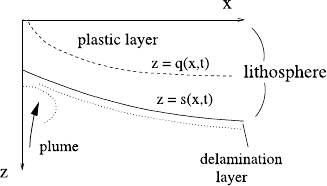
8.6 Subduction and the Yield Stress 519
Fig. 8.8 An illustration of
the region of plastic yield
within the lithosphere,
assuming a viscoplastic
rheology
Despite this, the ‘yield’ curve is often used to divide the upper mantle into a
plastic upper part (with brittle yielding), an elastic middle part, and a ductile lower
part. Such inferences appear to be groundless.
I want to propose a different kind of rheology which is consistent with observa-
tions of fault motion by earthquakes. This is that plastic yield should occur at a yield
stress τ
c
, which we will take to be typical of stress release in earthquakes, and much
less than the brittle Byerlee value. In essence, we associate this kind of failure with
subcritical crack propagation, and we do not distinguish necessarily between elastic
and viscous behaviour for stresses less than τ
c
. We can in fact allow a viscoelastic
deformation for τ<τ
c
, but it turns out that the elastic deformation is inessential to
the description, and we henceforth omit it.
Our rheology is thus viscoplastic, and takes the form
τ
ij
=2η ˙ε
ij
, (8.289)
where the viscosity η isgivenby(8.163)ifτ<τ
c
, and is determined in the plastic
case by the requirement that τ =τ
c
on the yield surface.
8.6.2 The Plastic Lid: Failure and Subduction
It is now possible to carry forward the boundary layer analysis of Sect. 8.5 to allow
the description of a plastic lid within the lithosphere, but we forgo the dubious plea-
sure of tormenting the reader further with this, interesting and intricate though the
analysis is. We confine ourselves to a description of the results.
The essential novelty is indicated in Fig. 8.8, which indicates that where the
stresses in the lithosphere exceed the yield stress, there is a plastic lid of dimension-
less (scaled with νd) depth q. In this lid, the material behaves plastically, while the
part of the lithosphere below the plastic lid is viscous. Intricacies include the fact
that there are boundaries at top and bottom of the lid (of thickness O(ε) relative to
the lid scale) in which the stresses jump.
From the analysis, we obtain relations for s as before, and also for the plastic lid
depth q. The analysis assumes a stagnant lid, and is thus self-consistent if q<s.
The reason for this has to do with the effective viscosity in the plastic lid. Our
assumption for the flow rule when the yield stress is reached is that increments of
